
Brad Pitt’s Make It Right Foundation built 109 eye-catching and affordable homes in New Orleans for a community where many people were displaced by damage wrought by Hurricane Katrina in 2005. Now this housing development is in disarray. The vast majority of the recently constructed homes are riddled with construction-related problems that have led to mold, termites, rotting wood, flooding, and other woes.
At least six are boarded up and abandoned. Many residents have filed lawsuits that are still pending. That is, a nonprofit that built houses with input from Frank Gehry and other prominent architects amid much fanfare for survivors of one disaster then ushered in another disaster.
Structural and other problems are making many residents fear for their health. Make It Right, despite what its name might suggest, has not resolved these issues and has stopped assisting residents. Instead, the movie star-led nonprofit has apparently become defunct.
As an urban geographer who researches on housing development, I’ve been following Make It Right’s travails since 2018, when residents tried to get the New Orleans City Council involved and have municipal authorities inspect the homes. The situation has only deteriorated since then, highlighting the perils that can accompany nonprofit housing development.
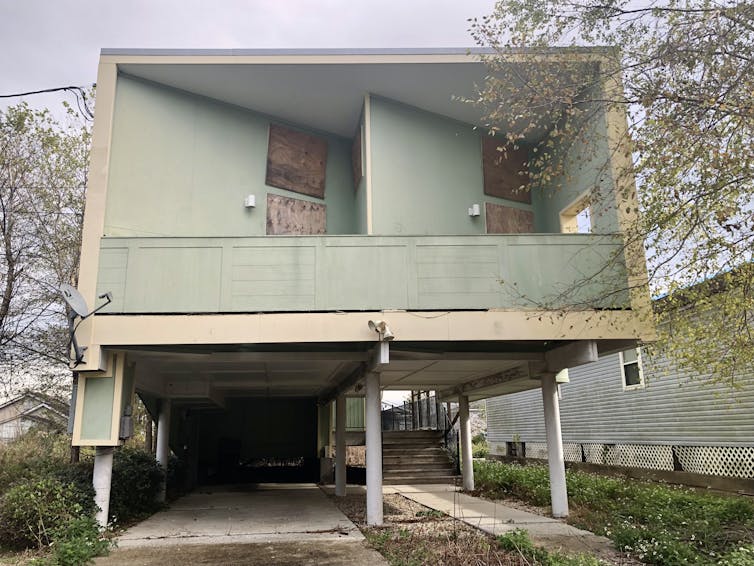
Supposedly sustainable housing
Located in New Orleans’ historically Black and low-income Lower Ninth Ward, this cluster of affordable homes built between 2008 and 2015 was unusual for several reasons. Notably, these residences were sold, rather than rented to their occupants.
The architects who created these homes also tried to make them green and sustainable following a “cradle-to-cradle” philosophy that centers around the use of safe and reusable materials, clean water, and renewable energy. All the homes had solar panels and energy-efficient heating and cooling systems.
Make It Right reported spending $26.8 million on the housing. To make the homes—which fell short of the group’s original goal of 150 residences—affordable, they were sold for less than it cost to build them, mostly around $150,000.
The nonprofit housing developer says its mission is to “improve the design and performance of affordable housing” and to “share best practices associated with the construction of such homes.”
Make It Right also sought to revitalize the Lower Ninth Ward and bring people together. For example, it built a community garden and held regular meetings for the new homeowners.
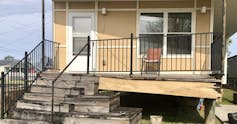
Although some of these structures are not yet a decade old, my data shows that only six remain in reasonably good shape. Most either have had partial repairs or have been completely renovated because of structural problems. Two were demolished because of severe mold problems.
Many of the houses lacked ordinary, essential features such as rain gutters, overhangs, waterproof painting, or covered beams—all of which are necessary to withstand New Orleans’ subtropical climate and heavy rainfall.
Brad Pitt, who took credit for launching this organization in 2007 and often served as its public face in subsequent years, was still listed as a board member as of 2018.
Pitt’s lawyers argued that he could not be sued over the housing development’s failings, but a judge ruled in 2019 that the movie star would remain a defendant because of his role as Make It Right’s founder and chief fundraiser.
Completely in shambles
I interviewed 11 residents, as well as seven urban planning experts who worked on the case. Additionally, I gathered data on the development and the homes by reviewing New Orleans property assessments and building permits. While staying in the Lower Ninth Ward myself, I personally took a census of the development and mapped its current state.
More than one resident told me they were initially very excited to be part of something bigger.
A Make It Right resident I’m calling Harry—I promised anonymity to all the residents I interviewed—had to move out of his home during major renovations that didn’t resolve all the issues he faces.
“They kind of got a second chance to make it wrong, not make it right again,” Harry told me. “They made it wrong twice.”
As of early 2022, six homes are vacant because of mold, rot, flooding, and assorted structural issues. Hanna, a young first-time homeowner, walked away from her Make It Right residence, which was later demolished.
Only eight months after she moved in, Hanna recounted to me, her home “was completely in shambles.” Its flat roof could not hold up in the heavy rains of New Orleans, causing massive water intrusion and subsequent termite infestation and mold.
Hanna struggles with health problems caused by toxic mold. “I would like to say that there is always a silver lining, but with this situation, I really don’t see a silver lining because it really changed a lot of my plans that I had for myself in life,” she said.
Most of the residents I interviewed were dealing with a similar state of constant uncertainty.
They don’t know how much longer their home is going to hold up, whether the mold they were exposed to is affecting their health, and, worst, what would happen to their finances if they were to lose their home.
“There is just no turning this off,” Harry lamented. “Sometimes I think I’m sitting on a time bomb in this house.”
Others described always being “on edge,” the situation being “very stressful,” and a feeling of having been “taken advantage of on the biggest scale.”
They wonder who they can turn to for help at this point.
“Something that’s been an incredible disappointment is . . . the retreat of Make It Right from any form of responsibility,” William told me.
A web of legal turmoil
When Make It Right failed to provide the assistance residents requested, several homeowners filed lawsuits. This litigation is reportedly still pending.
Some residents also blame local authorities.
“We also have an issue with the city, because those who inspect [the home] and are supposed to keep it safe, did not,” said Claire, who tried to get New Orleans’s safety and permits department involved.

My many efforts to reach out to Make It Right by mail, email and visits in person remain unsuccessful. When I went to its New Orleans office in December 2021, I encountered no staff. Instead, I witnessed a moving crew that had been hired by the organization to move its furniture and other property into storage.
The organization has apparently failed to file a 990 form, annual paperwork the Internal Revenue Service requires of all nonprofits, covering any year since 2018. Local media have reported that a bank is suing it. Its website has become defunct and the phone number it included in its 2018 IRS paperwork no longer works. Even the person who mows the vacant Make It Right properties has told reporters that the nonprofit owes him money. Make It Right, in turn, is suing several former executives and its chief architect for alleged mismanagement.
The journal The Conversation also attempted to reach out to the Make It Right Foundation by phone and email and was unsuccessful.
Make It Right has discontinued a similar affordable housing development that was in the works in Kansas City, leaving empty lots there in limbo. The nonprofit had also engaged in projects in Montana, where other legal issues arose, and New Jersey.
Who pays in the end?
Because one of the abandoned properties is turning into a safety hazard, the city is taking action to seize it. Make It Right’s 2018 IRS filings indicate that it was spending more by then on legal services than on construction and maintenance.
This mirrors the experiences of residents, who have not seen evidence of the organization’s engagement with their community for years. Many are starting to pay for repairs out of their own pockets rather than wait for the nonprofit builder to resolve issues caused by its shoddy construction.
“I did most of the work myself,” Mario told me. “The ceiling tiles on the porch were falling off, and the wood was rotting, so I just replaced it, slowly, you know, so we could afford it.”
Despite their experiences, some residents said they still believe Make It Right’s founder had good intentions. “I don’t blame Brad Pitt,” said David, another resident. “He had a vision to build low-income houses and get people back in the Lower Ninth Ward.”
While nonprofit housing developers can play a vital role in creating affordable housing, many questions remain regarding their accountability in this case and others, in places like Chicago and Washington, D.C.
Mismanaged housing developments, even when constructed with lofty goals, only compound the hardships of the low-income people they purport to serve.
Judith Keller is International Researcher Scholar of Geography at the University of Illinois at Urbana-Champaign. This article originally appeared at The Conversation.
Weekly Newsletter
Get building science and energy efficiency advice, plus special offers, in your inbox.





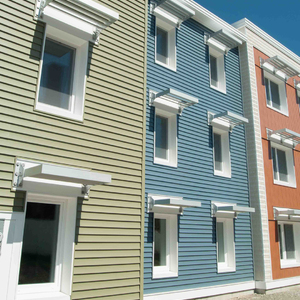
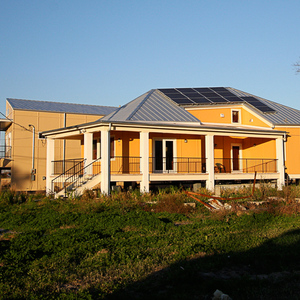

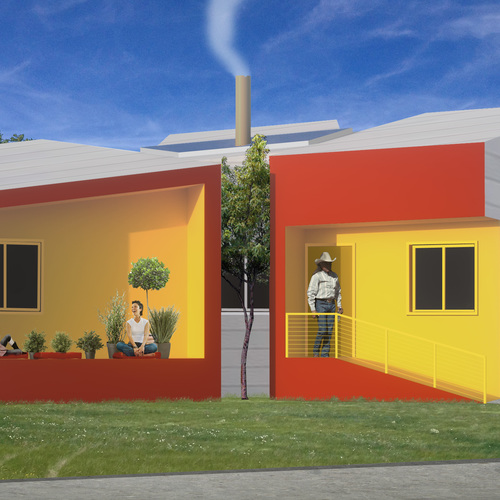






17 Comments
I'm confused. What were the actual problems with the buildings? I followed ~10 links and found only PR (both pro and con), but no building science diagnosis. The article says, "Many of the houses lacked ordinary, essential features such as rain gutters, overhangs, waterproof painting, or covered beams", which is a start, but I was hoping for more technical meat to the article. I don't mean to minimize the pain of the home owners, but thought there would be a more substantial technical focus on something posted to GBA. I don't live near NO, so "what not to do" would be interesting to me.
You bring up a good point, Erik. I reached out to the author for a fuller explanation of why the failures happened. This is what she shared:
You have to understand that as an urban geographer, I used ethnographic and qualitative research methods to study the Make It Right project. So, while I will try to respond to your question the best I can, you have to understand that this is not my main area of expertise.
The homes deteriorated as quickly as they did for a number of reasons:
1) Many of the home designs do not work in the context of New Orleans, where we have a high humidity, heavy rain falls, hurricanes and flood surges. I believe that a respect for local building knowledge and the local context would have helped to design homes that make sense in a location like New Orleans. But it seems like many of the architects placed more emphasis on design. Homes with flat roofs did not do well at all. The two homes that needed to be demolished were designed by Adjaye (built in 2011, demolished in 2020) and Timberlake (built in 2011, demolished in 2018). If you want to have a closer look at the building designs, there is a book called Architecture in Times of Need, which details all of them.
2) Some experimental materials were used that then proved to be insufficient for New Orleans climate. Again, something that could have been prevented if one had paid attention to how and where the materials were supposed to be implemented.
3) Many mistakes were made on the side of local contractors. It seems like the foundation tried to save money on the construction end, and so even some of the better home designs were executed to poorly that they needed repairs within no time. I'm talking about mistakes to the degree where windows were put in upside-down which caused water intrusion that could have been prevented.
4) Another issue, as almost always, is maintenance. However, I would be very careful not to blame that on the homeowners because many of them try really hard (and often against all odds and with limited financial resources) to keep up their homes. Also, Make It Right promised all homeowners on-site maintenance and the residents had warranties, but Make It Right failed to keep their word.
Wow, this is unfortunate. I know that Pitt and many others sincerely wanted to make a difference. I am sorry this failed....However, perhaps we can learn a few valuable lessons from this:
-Architects should never sacrifice durability for appearances...I don't know why so many architects love boxy, rectangular, flat roof designs with no soffits. This is asking for trouble in climates with a lot of wind driven rain.....My dad bought a house at the Jersey Shore that was built in the 50's as a glass, cedar and redwood box with no operating windows (just louvers) or soffits. It was designed by a prominent architect and looked futuristic for its time. But it leaked and many of the wood sills around the huge plate glass windows rotted. Seagulls loved to drop scallops on the flat roof to break them-landing with big "thuds" all day long! Eventually most of it had to be renovated and redesigned to a less striking but more sustainable structure.
-People wishing to build in an area they are not infinitely familiar with should never ignore the local knowledge base just to be different. Locals are usually not dumb, they often have valuable knowledge built from experience that is hard to replicate in a lab or computer simulation......So deviate from local norms carefully and only when you have a lot of strong evidence that your new design will work better.
-Trying out new materials/products in a harsh environment is also a big gamble. Locals typically have tested by trial and error local materials, so use these materials unless you have a lot of evidence that your new materials will work better.. Much of the exterior wood rot in the Make it Right projects is associated with using wood that used a unique untried non toxic treatment method, not standard pressure treated wood. I understand that it failed badly.
-Non profits and government entities often try to do too much or have too many competing goals when they embark on a project or projects. Here, Make It Right could have merely built relatively simple homes. Instead they got celebrity architects involved, tried to meet all kinds of environmental, sociological and economic goals, and probably spent too much time with media marketing the image. They should have spent more time searching out and vetting the best local builders.
-A typical mistake that non profits and governments often make is to over spend on building a project and then not have enough capital left for ongoing maintenance, repairs, operations, and education of the folks who use or live in the projects.
-These types of projects are tough. Don't come out of the gate too fast. Start small so you can learn from mistakes and continue on with more sustainable results.
My non profit group (Kageno.org) has worked in rural villages in Kenya and Rwanda for 15 years now, where we often fund projects like nursery schools, medical centers, libraries. We have learned many of the above lessons over the years. We stay in the villages for many years, listen to and work closely with the locals, and try to keep our ambitions and hubris in check. We have been successful when we do this.
The nation is now starting to gear up for a monumental conversion of much of its housing stock to clean energy and energy efficiency. It is a very difficult task that will have many set backs. I hope the government, industry and private sector can learn from mistakes like this one as quickly and painlessly as possible and ultimately succeed.
Four years ago I learned about this story. A complete failure from the start, it took time to unravel apparently and now here we are.
Maybe Brad Pitt is clueless and got swindled, maybe he wanted to do a feel good publicity stunt and is responsible. Maybe he should reimburse these folks for their headaches and emptied pockets.
Either way, it's good enough reason to keep Hollywood out of anything other than making movies.
Maybe Pitt should have practiced building movie sets first.
Whatever Brad Pitt and the others motivations, they should have stuck around until things were resolved. In for a penny, in for a pound.
I think the starchitects did more damage to the project than the Hollywood influences. I'm more appalled by the fact that they walked away than in the fact that Pitt walked away. How can they still be in business after that failure?
Putting all that money into Habitat for Humanity homes probably would've been a better use of funds.
This is a complicated story. Homes designed to a price point, issues with regards to acquiring and retaining competent tradesmen to build and perform warranty work. Homeowners who were not prepared for the required maintenance compared to the homes which were replaced.
NOLA would be better off of they just razed the area and returned it to swamp land.
John,
"Putting all that money into Habitat for Humanity homes probably would've been a better use of funds."
Yeah, but where is the fun in that? You see the same thing with a lot of charities trying to get aid for projects in the Third World. Everyone wants to fund a building, but no one wants to give money to the effective but boring public health initiatives or services that are already in place.
You are exactly right. That is why the charity I work with in Africa stays in a village for many years instead of popping from one to the next financing a structure or system and then moving on. We focus on health, education, economic ventures and environmental programs. They are all related and must work together. When we finance a building like a clinic or nursery, we typically have a plan and budget in place to staff it, maintain it, operate it and improve upon it. In addition, we use local people to build and staff a project or program so their salaries support and enrich the local economy. Unfortunately, as you say, it is easier to raise funds for specific projects (like a maternity clinic) than for programs like HIV education.....
Nick,
I'm sure you know a lot more about this that I do. Well done!
Thanks. I think when we are dealing with non profit or government work, many times intentions exceed capacity...it requires great discipline to work within our means and practical realities.
I figured the Louisiana Chapter of HFH would have a better handle on how to build for the climate and have the trades on hand to build it correctly and do honest work rather than a half@ss job.
Why anyone would build a wooden houses with no overhangs is beyond me, and reminds me of the rail-less stair discussed recently. Interesting but dumb. I love interesting architecture, but it really should work.
I'm a lifelong resident of the New Orleans area. This article and most comments are accurate.
These were beautiful and striking houses when they were new, but I remember seeing them and being astonished that most (all?) had flat roofs, absent or insufficient overhangs, wood features that would hold a bit of water and deteriorate even if the wood was painted or pressure-treated, which it often wasn't. These are beginner mistakes. It's like the architects knew nothing about designing a building for a tropical climate.
They did some nice things with water management once it was on the ground, though, in terms of swales, french drains, holding areas, native plants. These do require maintenance, though.
It's not fair to blame Brad Pitt, who had the best of intentions, and whom we can't expect to be knowledgeable about appropriate design for local conditions (unless he rejected designs with conventional sloped roofs, gutters). The fault is with the architects and builders.
It's too bad that the architecture profession doesn't do better at celebrating the architects who have the comprehensive set of skills needed to design buildings that work across all the different dimensions, and who have the humility to know where they need to bring in appropriate expertise, and to listen to tradespeople. Then Brad Pitt would have been told to hire people like Micheal Maines, Emily Motrin, Robert Swiburne, and others that I unfortunately don't know about, or the local equivalents in the region.
Nola Sweats,
I'm not as quick to absolve Brad Pitt. He likes to dabble in architecture, and even named one of his children after Jean Nouvel. He used the moment to assemble a group of his favorite celebrity architects so they could play - much as you see architects do when they hold competitions for them to design dog houses or planters - and with similarly impractical results. When it wasn't fun anymore they all disappeared. Pitt included.
When it comes to architects, I think a good rule of thumb is to use local people unless there is a good reason to do otherwise; and even then, have local architects and builders on call to consult. A second rule of thumb is "leave the hubris at home".....
Having said that, some of these mistakes seem so obvious!
Log in or create an account to post a comment.
Sign up Log in